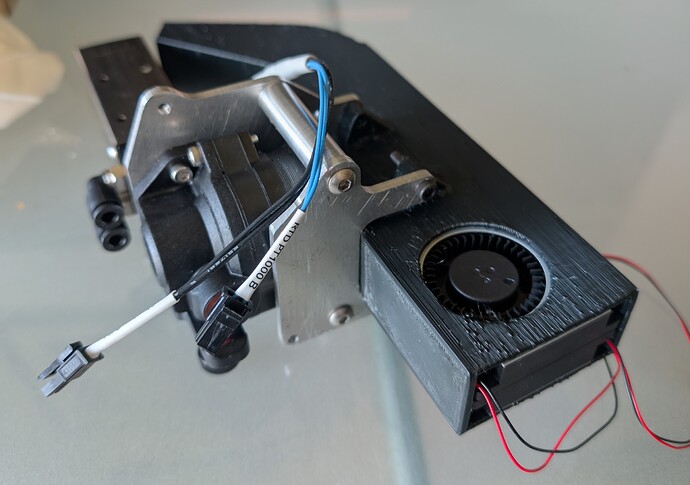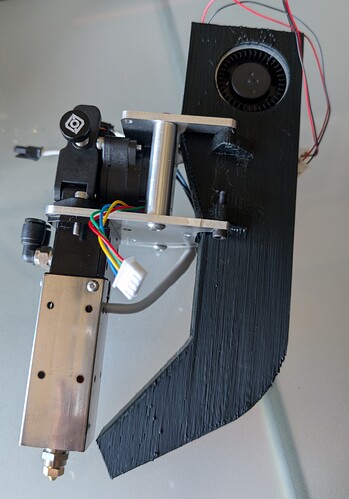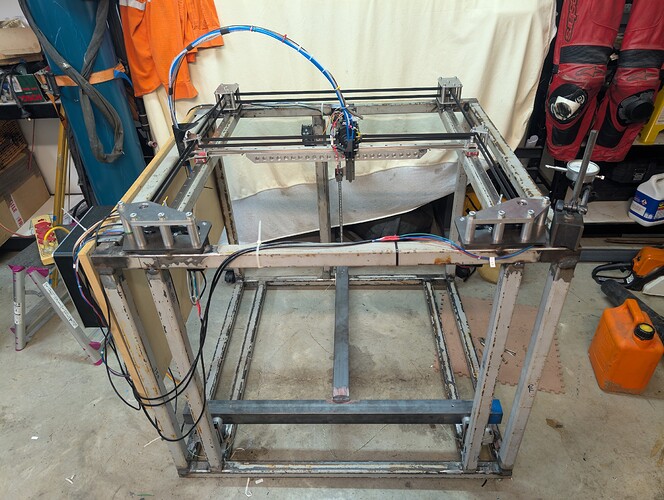THIS is a video of Z being load tested.
Hot end progress…
The belts will wrap on the cylinders, and the bottom plate screws directly to the rail carriage (needs countersunk screws).
The top plate is designed to take a bigger fan for part cooling, but I’ll run with the ones that came with the end to start.
The hot end is this one: STD6-LC
I need to figure out the attachment of the Klicky switch next.
The plates were cut and drilled on the MPCNC, 3mm 5083 aluminium.
I got myself in a pickle I bought 2 DM542T drivers on the assumption I’d be able to do simple flying leads from the driver socket on the controller board to the stepper driver, however I’ve run into 2 problems, maybe some of you might have experience with this?
-
The names on the pins are different between the 2 so the mapping is not obvious, and I’ve found nothing on the web to describe such a set up, so now I’m not sure it’s possible, also I found this Stepper Driver Adapter Module which has the right pin out but does not appear to go into a board designed for TMC drivers?
-
What would go in the printer.cfg? I’d assumed if I left that as configured for a TMC5160 then just mapped the pins based on that it’d work, now I’m not so sure.
The controller board is a Fysetc Spdier v1.1
Things have moved on, here’s what it looks like now:
And here’s in moving, doing a Z tilt adjust, nerve wracking stuff when pressing the buttons for the first time.
Big 3D printer Z tilt adjust first runs. - YouTube
There’s a lot more to do with the hardware and code, but it’s getting there.
Heck yeah, that is a beast.
To make first moves less scary I run the steppers at a super low current just in case of a crash. Turn them back up later for speed tests.
Man that thing is a beast!
Man that is a good idea. I don’t ever think of things like that and just watch it crash and then try again LOL. But then again none of my printers are all welded steel frame like this one lol
Man, look at that rail backer!! I used a piece of aluminum angle for mine. ![]()
@vicious1 Wish I’d thought of reducing the current, that’s a great idea.
That is pretty amazing!
Extruded aluminum is difficult because it can be easy to knock it out of square, but can be adjusted back into square. If your frame is off just a bit, do you cut and reweld or skew compensate? I can run a bead, but getting things dimensionally accurate proved near impossible when i tried welding. Congrats to you for making this!!
I bet a heavy frame can be a benefit for vibration damping. Are you using z brake for the bed?
@orob I’ve yet to melt plastic, a lot of this is yet to be found out. I put a lot of effort into getting it as flat and square as I could when welding the frame. I’ve a slab of old polished granite counter top for a reference surface, but once I get into calibrating the parts coming off of it we’ll find out if I did a decent job or not.
Trying to keep it flat was mostly lots of clamps when welding and then twisting it back flat again to take out the inevitable movement.
My hope is with the sturdy frame I can run it at speed, otherwise prints this size will take for ever.
For sure. Just wanted to seed the question in the hopes you will detail it out as it unfolds. I’m watching with interest and hoping to learn from the shared information.


